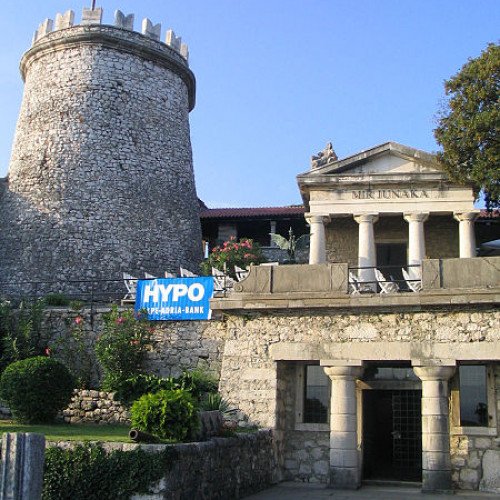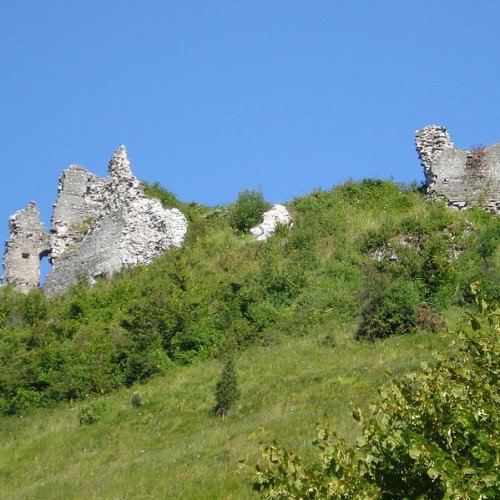Castles of "Croatia" TRSAT CASTLE vs TRŽAN CASTLE IN MODRUŠ

TRSAT CASTLE
Trsat Castle (Croatian: Gradina Trsat) is a castle in Trsat, Croatia. It is thought that the castle lies at the exact spot of an ancient Illyrian and Roman fortress. The Croatian noble Vuk Krsto Frankopan is buried in one of the churches. The Trsat castle was completely reconstructed and renovated in the 19th century when the mausoleum of the military commander Laval Nugent was built in its interior. The courtyard of the castle has now been turned into a restaurant and many tourists visit the place during the summer months. The thirteenth century Trsat castle, whose site has been in use from Roman days for being an easy place from which to control access to the sea along the Rječina River, is situated on the steep hill overlooking the Rječina gorge on its left bank, just above the town of Rijeka. It may be that a Iapodian hill-fort, Darsata, used to be there, after which the Roman fortification Tarsatica was named. This Roman fort was of vital importance on a road that connected Aquileia to Pannonia and Senia (Senj). It was owned by Frankopan family who built the present castle, on the site occupied by the Illirian Tarsatica, to protect their holdings in Vinodol. The capture of the Castle of Trsat compelled the Ban of Croatia, Andrew Bot of Bajna (Bajna is a village in Hungary, near Esztergom)), to intervene in the Austro-Venetian war, and in June 1509 he first recaptured Trsat with his Croatian army and then entered Rijeka after expelling the Venetians. In October 1509, the Venetians withdrew for good and Rijeka returned to the possessions of Maximilian of Habsburg. This notable episode is the sole event which links Rijeka with Venice, and consequently with Italy, during the whole of its history from the 7th century on.
Statistics for this Xoptio

TRŽAN CASTLE IN MODRUŠ
The Tržan Castle (Croatian pronunciation: Croatian: Tržan-grad or Utvrda Tržan) is a ruined medieval castle above the village of Modruš in the northern part of historical Lika region, central Croatia. Before (from the 11th century) the administrative seat of the former Modruš County (later renamed Modruš-Rijeka County), it is today a ruin in the Josipdol Municipality in the southern part of the Karlovac County. Having been built on a ridge of a steep hill 670 metres (2,200 ft) above sea level on the eastern slopes of the Velika Kapela mountain, the castle was at a strategic place overlooking the road that connected the Adriatic Sea and the Pannonian Basin since ancient times. The road in question connected the Roman towns of Senia (present-day Senj) and Siscia (present-day Sisak). It was later, during the 18th century, reconstructed, improved and renamed as Josephina road. According to the famous Croatian historian Vjekoslav Klaić (1849–1928), a kind of a castle or stronghold most probably existed above Modruš already at the beginning of the 9th century, during a war between Borna, Duke of Dalmatian Croatia, and Ljudevit Posavski, Duke of Lower Pannonia. Almost ideal position, dominating over the surrounding area, made Tržan Castle never to be conquered by anyone in its history, although the town of Modruš below the castle was plundered and burned by the Ottomans in 1493, just before the battle of Krbava Field. From 1193 the castle was property of the Knezes (Princes) of Krk, (later, from around 1430, known as the Frankopans), a distinguished Croatian noble family. Bartol II Krčki /Bartholomew II of Krk/ was given the whole vast Modruš estate, including the castle, by the Croato-Hungarian king Bella II (III) for his merits in the wars he fought. The next more than 350 years Tržan was owned by the Frankopans, not only as one among the many castles in their property, but as the main seat and stronghold of the family in the whole continental part of Croatia. From thence ruled, among others, Ivan V Krčki /John V of Krk/ (born before 1343, died 1393) and his son Nikola IV /Nicholas IV/ (born around 1360, died 1432), the most powerful man in Croatia at the beginning of the 15th century, both Bans (Viceroys) of Croatia. They reconstructed and enlarged the old, irregular shaped castle, which was from around 1437 called Tržan or Tržan-grad, because of an increased trade that was going on there (Croatian: tržiti means to trade or to sell).